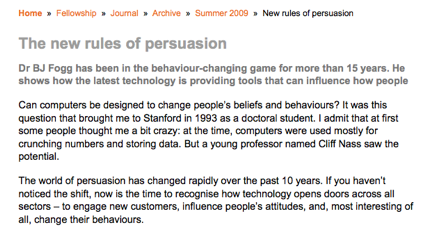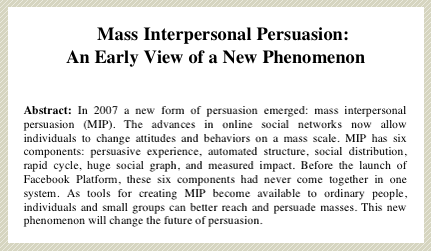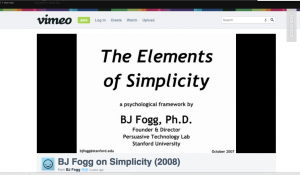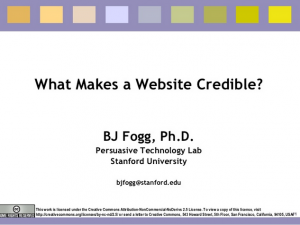by BJ Fogg, Ph.D.
Director, Persuasive Tech Lab at Stanford University
The world of technology has changed dramatically in twenty years. In 1993, I went to Stanford University to study how to automate persuasion. As a doctoral student, working with Cliff Nass and Byron Reeves, I was trained as an experimental psychologist. I had one question I wanted to answer: How could you computerize persuasion? In other words, how could you use the power of computers to change what people believed, how they behaved, and how could this then be applied to improve the world in some way?
The first experimental studies we performed at Stanford were not received very well by outsiders. I remember presenting the results at an academic conference, and at the end, there were 3 reactions: 1) people didn’t believe the data – they thought somehow we had run a flawed experiment; 2) people thought the work was evil, that it was equivalent to creating the atom bomb; or 3) (and this was just a small segment of the audience) they found the work fascinating, and they could see the immense application in the future.
We continued the experiments. As part of the CASA research group at Stanford, I focused exclusively on persuasion, specifically how computers could leverage social dynamics such as group support, personality differences, praise. I explored how those social dynamics could change people’s opinions and, even more importantly, their behaviors.
After we ran a number of experiments, and after these studies were replicated elsewhere, the results were undeniable. Computers could indeed be designed to influence people, to change their thoughts and behaviors. Today, this notion that computers can persuade people is no longer novel. In fact, experiments to show this phenomenon aren’t interesting because we now have thousands of Internet services, applications for mobile phones, experiences and social networks like Facebook, that change our behavior on a daily basis; they influence us. Computing technologies are not only changing us individually, but are changing our culture. So in twenty years, we have come a very long way from computers being seen as machines to store and manipulate and crunch data, to machines that are part of our everyday lives—machines that influence our thoughts and actions, our friendships, and even the relationships between countries.
Today, we are surrounded by persuasive technologies. Everywhere that digital media touches our lives, more and more there is an element of persuasion; a design created by humans and implemented in code to influence what we think, and more and more, what we do. We are surrounded. Persuasive technology is in our living rooms, in our cars. When we communicate with our loved ones online, through Facebook, persuasion is there. When we withdraw money from the bank at the ATM, an element of persuasion may be there. When we purchase a gift online for a birthday, once again, we are being exposed to persuasion. In fact, we carry a persuasive platform, the mobile phone, with us most everywhere we go.
Yes, we’ve come a long way in twenty years; technology has shaped who we are. In fact, I believe the mobile phone is the next step in human evolution, literally. Almost everyone coming into the world will have a mobile phone with them, by their side, for the rest of their lives. We are not just flesh and bones; we are now flesh and bones augmented with technology, and we will live the rest of our lives through technology connections, leveraging the power.
This is the current state of affairs, and it is our future. There is nothing we can do, like it or not, where we can escape persuasive technology. This makes it all the more important to understand what the potentials and pitfalls are for creating machines that influence humans, because in essence that is what we are doing. We are creating machines that control humans and human behavior. On the face of it, this seems a radical, even heretical, notion. It’s notable that not more people have become upset by this prospect. If twenty years ago, I had announced that we would soon be creating machines that control humans, there would have been an uproar. But today, the uproars around Facebook, around Google’s domination, around Apple’s seductive products, are small compared to the actual impact this is having in our lives. Understanding what’s going on today with technology and influence helps us to see the future.
Technology will continue to change. That’s something that makes working in persuasive technology so exciting. Every day, a new development, a new start-up, a new product, something that opens new potentials for persuasive technology; it is never static, always dynamic. It can be daunting to stay current with all the new developments.
But there is a constant in persuasive technology. That constant is human psychology. For thousands of years, we humans have fundamentally been motivated by the same things. We’ve had the same types of mental abilities and so on. Because human psychology is the constant in the world of persuasive technology, the more we learn about what makes humans tick, what motivates us, what capabilities, what weaknesses, what we aspire to, what we fear — the more we learn about human nature, the clearer our understanding of persuasive technology will be.
In my training as an experimental psychologist, I’ve come to appreciate over the years the grounding in human psychology and understanding humans first, and understanding how technology is then a channel for helping humans achieve their goals, for influencing people to do better, for changing organizations, and yes, for transforming the world; for that is, indeed, my hope for persuasive technology and for the innovations in this arena: that we can use the power of digital technologies, we can leverage the scale and speed of social networks to bring about positive changes in relationships, in environmental behavior, and in our health, both at local and global levels.
If I weren’t an optimist about human nature, I would be worried about the future. But I am an optimist. I believe that we humans are fundamentally good. Now that persuasive technology is being put into the hands of millions of people (for example, my mother can start a group on Facebook and influence hundreds or thousands or perhaps millions) the tools for creating these systems are no longer given only to the highly trained or to large companies. More and more everyday people can create websites, can create applications, can reach out, and this is a good thing, I believe, because humans are basically good; because they want to do good things in the world.
By empowering millions of people to create persuasive experiences with technology, we will have thousands, and perhaps millions, of forces working toward the better in the world. And that, I believe, offsets the negative: the power that evil people and corrupt organizations will gain with persuasive technology.
So I encourage you the reader, as you move forward through the pages of this book, that you keep primarily in mind how the potential of the technology can be used to make the world a better place: more peaceful, more prosperous for everyone; how technology can help individuals be happier and be better contributors in their communities. This book explores some important issues of technology and its effect on individuals, our communities, and our culture. It is my hope (as with my classes at Stanford, the work I do in industry) that you will use what you learn in these pages to bring about positive changes in the world, and that you will inspire others to do the same.
Dr. BJ Fogg
Stanford University
November 2010
 In May 2012, the Persuasive Tech Lab hosted Mobile Health 2012: Baby Steps for Big Change. We took a slightly different angle in 2012. Why? Because this method — rapid baby steps — leads to success in three areas: behavior change, collaborations, and experience design. We realize that “baby steps” is an odd focus for an entire event. But we thought it was absolutely the right focus for 2012. The chronic problems in behavior change, collaborations, and product development have a common solution for innovators in Mobile health — and that solution is baby steps.
In May 2012, the Persuasive Tech Lab hosted Mobile Health 2012: Baby Steps for Big Change. We took a slightly different angle in 2012. Why? Because this method — rapid baby steps — leads to success in three areas: behavior change, collaborations, and experience design. We realize that “baby steps” is an odd focus for an entire event. But we thought it was absolutely the right focus for 2012. The chronic problems in behavior change, collaborations, and product development have a common solution for innovators in Mobile health — and that solution is baby steps. Presenter Slides from Mobile Health 2011
Presenter Slides from Mobile Health 2011


